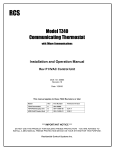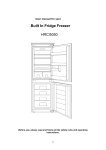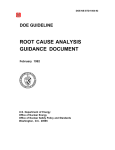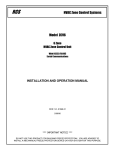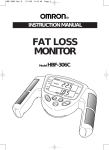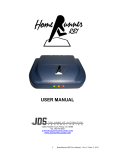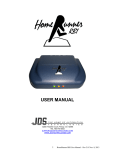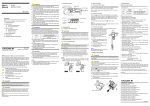Download Residential Control Systems TR16 Unit installation
Transcript
RCS Residential Control Systems Inc. Model TR16 Communicating Thermostat With RS485 Communications INSTALLATION AND OPERATION MANUAL Rev P HVAC Control Unit DCN: 141-00930-09 Rev 09 7/13/06 This revision of the document applies to the following part numbers and revisions or later. Product TR16-485 Thermostat TS16 Wall Display Unit HFR-485 HVAC Control Unit Rev P G P Part No 001-00930-30 001-00910-12 001-01430-03 Firmware TS16v340 HFR3052 *** IMPORTANT NOTICE *** DO NOT USE THIS PRODUCT FOR BUILDING FREEZE PROTECTION! YOU ARE ADVISED TO INSTALL A MECHANICAL FREEZE PROTECTION DEVICE FOR THIS PURPOSE. TR16 Operation The TR16 thermostat provides the latest technology in a full-featured universal thermostat with serial communications. The TR16 has many new features including: • • • • • • • Separate Heating and Cooling setpoints Multistage HVAC systems support Wall Display Unit setting of o Network Address o F/C temperature display mode o Sensor calibration (internal and remotes) Automatic Remote Sensor detection AutoSend Mode for network communications Adjustable operating parameters from the network Enhanced serial protocol The TR16 thermostat consists of two parts, a Wall Display Unit (WDU) and a HVAC Control Unit. The Wall Display Unit provides users functions like a traditional thermostat and connects to the Control Unit by a 4 wire cable. The Control Unit connects at the HVAC system using the standard thermostat connections and provides the thermostatic temperature control of the system. The Control Unit also has the serial RS485 communications network connection. The TR16 now maintains separate heating and cooling setpoints. The display shows the setpoint of the current operating mode (in Auto mode, the system keeps track of the current operating mode of the last call, either heating or cooling). New network commands have been added for a heating setpoint (SPH) and a cooling setpoint (SPC). Note that the TR16 maintains compatibility with single setpoint protocols by continuing to support the current SP command for both commands and status reports. In addition to the universal Standard or Heat Pump HVAC systems support, the TR16 has multistage heating/cooling system outputs. The control unit can support 2 stages of heating and cooling for Standard systems. It supports 3 stages of heating and 2 stages of cooling for Heat Pump systems. The TR16 has a convenient setup mode from the Wall Display Unit. You can set the network address, F or C display mode and easily calibrate the internal and all attached remote sensors. The TR16 has automatic detection and setup of remote temperature sensors. Remote sensors have address settings that, when detected by the TR16, will be used for specific functions, such as, in lieu of the internal sensor, averaging with other sensors. The TR16 can be used in a polled network such as the RCS CommStar network or can be set to AutoSend mode that will transmit changes in thermostat data as it occurs. Most operating parameters (variables), such as staging deltas, delays and run times are now viewable and adjustable from the network. Remote control of the TR16 via the serial communications network allows for the thermostat’s temperature, heating and cooling setpoints, operating mode and fan functions to be monitored or changed. A robust serial protocol allows full control of all the thermostat setup and operating parameters. Many new serial commands have been added to support the new features and to allow the operating parameters to be viewed or changed. DCN: 141-00930-09 7/13/06 2 TS16 Wall Display Unit The TS16 Wall Display Unit has a LCD display and control buttons for changing the setpoint, system operating mode and manual fan mode. The WDU also has an internal temperature sensor. The display serves as a common display for many functions. It normally shows the current room temperature but switches to show setpoint, mode or other functions when buttons are pushed. Two on-screen indicators show the state of the manual fan and setback mode. Any changes, such as the temperature or control button operations at the WDU are sent to the HVAC Control Unit. In turn, the Control unit sends changes in setpoint or modes from the serial communications network to the WDU. When updates are received by the WDU, they are displayed on the LCD display for 3 seconds and then the display returns to the current room temperature. TS16 WDU LCD DISPLAY Shows current temp normally. Shows setpoint or mode when buttons pushed. .7.5 Setback Mode On Indicator Manual Fan On Indicator Setpoint Increase Button Setpoint Decrease Button MODE FAN System Mode Button Manual Fan Button LCD Display The LCD display is a two digit multifunction display that normally shows the current room temperature. It has a continuous backlight for easy viewing anytime. Whenever any of the control buttons are pushed, the LCD display will change to show that function’s current status. The LCD display will stay in the new display mode as long as buttons are being pushed. After 3 seconds of no activity, the display will change back to show current temperature. The right decimal point on the LCD display will turn on whenever manual fan is ON. The left decimal point will flash whenever the setback mode is ON. Remote changes in setpoint or modes that are received by the WDU from the Control Unit will cause the LCD display to switch and display the updated data for 3 seconds and then return to room temperature. Temperature Display The WDU will normally display the room temperature from the internal digital temperature sensor or a remote sensor if attached. The WDU will display temperatures from -9°F/C to 127°F/C. Temperatures less than 0° will be displayed down to -9 ° as negative numbers. Temperatures below –9 will also be displayed but no minus sign can be displayed. Temps over 100° will be displayed without the leading 1 (ex: 102 will be displayed as 02°.) Outside Temperature Display If you attached a remote temperature sensor to the WDU that is set to remote sensor address “4”, you can view this outside temperature by pressing the UP and DOWN buttons simultaneously. Outside temperature data may also be sent to the WDU via network commands and viewed this way. Note if you press the UP/DOWN buttons and no temperature information is available, the display will show “- -“. DCN: 141-00930-09 7/13/06 3 Control Buttons Setpoint UP and DOWN Buttons The UP and DOWN buttons control the heating or cooling setpoint temperature. TO VIEW THE CURRENT SETPOINT: Push either the UP or DOWN buttons once will cause the LCD display to change to show the current setpoint temperature (but won’t change it). TO CHANGE THE SETPOINT: With the setpoint displayed as above, push the UP button to increase the setpoint temperature by one degree or push the DOWN button to decrease the setpoint by one degree. Pushing and holding a button down will cause the setpoint to continuously ramp up/down until the button is released. After 3 seconds of no activity, the LCD display will change back to show the current room temperature and the new setpoint value will be sent to the Control Unit. NOTE: You cannot change the setpoint when in the OFF mode. Setpoint Display The displayed setpoint shows the setpoint of the current operating mode (heating or cooling) of the system. If you change modes, the setpoint displayed will change to the new operating mode setpoint. If you set the mode to AUTO mode, the setpoint displayed will be the current operating mode of the system, either heating or cooling. This will change if the operating mode changes automatically. MODE MODE Button The MODE button sets the HVAC system Heating or Cooling mode. TO VIEW THE CURRENT MODE: Push the MODE button once and the LCD display will change to show the current mode. TO CHANGE THE MODE: While the mode is being displayed, pushing the MODE button again will go to the next mode. The system mode cycles from Off to Heat to Cool to Auto and back to Off again with each push of the MODE button. Once you stop pushing the button (for 3 seconds) the new mode will take affect and the display will change back to room temperature. When Heat Pump HVAC system type is selected on the Control Unit dipswitch, an additional system mode of “EH”, or Emergency Heat, is included in the TS16 mode selections. EH is used when Heat Pump compressor failure requires the use of Auxiliary Heat (heat strips) for primary heating. When EH mode is selected, the display will alternate between current temperature and “EH” to remind you that the EH mode has been selected. FAN FAN Button The FAN button controls the HVAC system’s manual fan mode. Pushing the FAN button once will turn the fan ON and pushing it again will turn the fan to the AUTO mode (which is OFF unless the fan is automatically turned ON by the heating or cooling operation ). The decimal point in the middle of the two digits on the LCD display will come on when the manual fan is ON. Changes in the fan mode will be sent to the HVAC Control Unit. DCN: 141-00930-09 7/13/06 4 Setup Mode The TR16 has a new setup mode to allow the user to set the following functions from the WDU: • Serial Network Address • F/C mode • Sensor Calibration Entering into the setup mode. Enter the setup mode by the following procedure: 1. First press and hold the Mode button 2. Simultaneously press the Fan button. 3. The display will change to show “SU”. 4. Release all buttons. 5. The display will change to show the setup menu, starting with “Ad” (address) 6. Select what setup function you want to change or view by pressing the Mode button to cycle through the menu options: “Ad” Serial Network address “FC” Fahrenheit or Celsius mode “C1” Calibrate Internal Sensor (or Remote Sensor address 1 if attached) and if additional external sensors are attached they will appear also: “C2” (if Remote Sensor address 2 attached) “ Viewing the Network Address When you first enter the setup mode, the first menu selection displayed on the LCD display is “Ad”. To view the current address setting, press the UP or DOWN button once. With the current address displayed, you can either change the setting or exit by pressing the mode button or wait for the screen to time out. Changing the Network Address. While the current address is being displayed, as above, use the UP/Down buttons to set the new network address desired, 1 to 254 (default set to 1). Since the TS16 WDU has only two digits of display, the decimal point between the digits is used to indicate when you are in the 100 to199 range (shown as 0.0 to 9.9). The decimal point to the left of the digits is used to indicate addresses in the 200 to 254 range (shown as .00 to .54). To exit press the mode button again or wait for the screen to time out and return to the normal thermostat temperature display. Setting the Fahrenheit or Celsius mode In the setup mode, press the mode button to select “FC” mode. The TR16 is default set to F mode. To change the degree mode, press the UP/DOWN buttons to select F or C as desired. To exit press mode again to move another setup mode or wait for the screen to time out and return to the normal thermostat temperature display. Setting the Sensor Calibration In the setup mode, press the mode button to display the sensor calibration address, “C1”, to be calibrated. ”C1” is the internal sensor and normally that is all that will be available to calibrate unless external remote sensors are attached. These will show up as “C2”, and “C4” in the menu selection, if present. With the desired sensor address displayed, press the UP/DOWN buttons to change the sensor calibration to the desired temperature. See calibration explanation below. Exit setup mode When you are done making changes and no button is pressed for 5 seconds, the display will automatically exit setup mode and return to the thermostat mode and current temperature display. Temperature Display Calibration The TS16 WDU has the capability for the user to adjust the temperature display calibration of the internal sensor as well as all attached remote sensors from the WDU in the setup mode. Normally the TS16, with no attached remote sensors, will only show the internal sensor as “C1” in the calibration setup menu. The TS16 can have additional remote sensors attached. These are addressed as DCN: 141-00930-09 7/13/06 5 remote sensors 1 and 2. If they are detected by the TS16, they will show up in the calibration menu as additional sensors to calibrate as C1 and C2. Note that if remote sensor with address 1 is attached it replaces the internal sensor and becomes the “C1” sensor. See the remote sensor section for more details. When the desired sensor is selected in the setup menu, you can adjust its displayed temperature calibration up or down 7 degrees by pressing the UP/DOWN buttons. The calibration menu selections are: C1 = calibrate internal sensor or remote sensor address 1 if attached C2 = calibrate remote sensor address 2 (only shows up in menu if attached) Remote Sensors The TS16 Wall Display Unit has a remote sensor terminal block, J2, on the base for connection of a remote temperature sensor. Remote sensors have an address that can be set to 1, 2, or 4. Without any remote sensor attached, the WDU uses the internal sensor for the current temperature information. When a remote sensor is attached, the WDU will detect it automatically and will use the remote sensor(s) according to its address selection. Modes of operation are as follows: Address 1: Use this remote sensor instead of the internal sensor. (becomes C1 in the calibration setup). Address 2: Average remote sensor 2 with internal sensor or sensor address 1 if attached. (C2) Table of Remote Sensor Functions and Sensor Addresses Function Use internal sensor only Used as remote sensor only Average internal and one remote Average two remotes (only 2) Remote Addr 1 No Yes No Optional with A2 Remote Addr 2 Yes No Yes Yes with A1 When averaging sensors are used, the average temperature is displayed on the WDU and reported to the HVAC control unit. You cannot view an individual remote averaging sensor temperatures as the main thermostat display or report individual sensor temperatures on the communication port. However, you can check the individual sensor temperatures by going to the calibration setup menu and selecting the sensor address. You can view the outside temperature by pressing both the UP/DOWN buttons simultaneously. Display Lock The TR16 WDU control buttons can be locked to prevent unauthorized changes in system operation from the WDU. The display lock/unlock state can only be set by the “DL” network command. See the Serial Protocol Manual for details on this command. “CF” or “SF” Error Displays If the WDU is not properly wired or if communications to the Control Unit is interrupted, the LCD display will display “CF” to denote Communication Failure. Momentary display of “CF” caused by bad or lost data, will clear automatically when data communication is restored. If the “CF” continues to be displayed, check wiring for problems. A continuous “CF” display may indicate a problem with the Control Unit or the WDU itself. An “SF” display indicates a temperature sensor failure. If this is displayed continuously, the sensor is failing to respond and must be replaced. This can also be displayed when attempting to view the outside temperature if this sensor has failed or been disconnected. DCN: 141-00930-09 7/13/06 6 TR16 HVAC Control Unit The TR16 HVAC Control Unit works in conjunction with the Wall Display Unit to provide thermostatic control of the HVAC system. In addition, the Control Unit can receive serial RS485 commands for remote control of the heating/cooling setpoints and mode of the thermostat. The TR16 can also report various status information via the serial communications network. The TR16 Control Unit connects to the HVAC system the same as, and in place of, a standard thermostat. It is usually mounted near the HVAC system, although it can be mounted anywhere convenient. It is connected to the WDU by a 4 wire cable, either standard thermostat wiring or typically Cat 3/5 in new construction. Actual thermostatic control of the HVAC system is provided by the Control Unit. Changes in the current temperature, setpoint, system or fan modes are sent to the Control Unit either from the WDU or via serial commands. The Control Unit monitors this information and operates the HVAC system accordingly. HVAC System Compatibility The TR16 works with almost all heating and cooling systems, including standard Gas/Electric, Heat Pump, Radiant, or Hydronic systems and with single or multi-stage systems. Compatible with single or separate transformer heating/cooling systems (Note: one stage heat only for split heat/cool transformers). System Type Gas Electric Heat Pump Heating Stages 2 2 3 Cooling Stages 2 2 2 Notes Single or split transformer Selectable Fan with Heat Selectable Changeover with Heat or Cool STANDARD GAS/ELECTRIC HVAC SYSTEMS OPERATION The TR16 has typical HVAC system operating modes of Heating, Cooling and Auto changeover. In additional to the multiple stages, the TR16 has adjustable temperature difference (delta) between stages and an adjustable deadband between heating/cooling setpoints. These control unit variables can be changed via network commands. The examples below are based on the default settings. In the HEAT mode, the stage 1 heating will be turned on at one degree below the heating setpoint and will turn off at the setpoint. In the COOL mode, the stage 1 cooling will be turned on at one degree above the cooling setpoint and will turn off at the setpoint. This is referred to as the setpoint delta. It is default set to 1 deg but can be changed via network commands. Second stage heating/cooling deltas are factory set at 3 degrees. This means that second stage will come on when the delta from setpoint reaches 3 degrees. Second stage heating/cooling calls will stay on until the first stage setpoint is satisfied. In the AUTO mode, the system will maintain the heating or cooling setpoints and switch automatically from heating mode to cooling mode as needed. There is a deadband between heating and cooling setpoints that keeps the two setpoints from overlapping. This is default set to 4 degrees, but can be changed. Setpoint Push. If you adjust the heating setpoint to be less than 4 degrees from the cooling setpoint, the cooling setpoint will be pushed to maintain the 4 degree deadband separation. Same for adjusting the cooling setpoint, if you get within the deadband separation, the heating setpoint will be pushed. Minimum Run Time (MRT). The HVAC control unit has a minimum run time that starts with every heating or cooling call. The HVAC system will run this minimum time even if the temperature reaches setpoint before MRT times out. However, if the mode is set to Off, the MRT will be canceled and the DCN: 141-00930-09 7/13/06 7 system will turn off immediately. The default MRT is set to 6 minutes but can be adjusted by the network system variable command from 1 to 9 minutes. Minimum Off Time (MOT). The HVAC control unit has a minimum off time after every heating or cooling call is completed. This off time is used for short cycle protection to prevent compressor damage after cooling calls (and heat calls for Heat Pumps). In addition, the MOT helps both Standard and HP systems to prevent rapid cycling of the system, caused by quick temperature changes. The default MOT time is set to 6 minutes but can be adjusted by the system variable network command from 5 to 9 minutes. The Status LED on the Control Unit circuit board will flash twice during MOT/MRT periods. Standard HVAC System Setup Standard System Mode Selection. To set the Control Unit for standard GAS/ELECTRIC operation, set the dipswitch SW1 position 1 to the STD SYS position (SW1-1 = OFF). Fan Mode Selection. Normally, GAS heating systems DO NOT require fan calls along with the heat call due to automatic fan operation in the furnace. For Gas systems, dipswitch SW1 position 2 should be set to the OFF position (SW1-2 = OFF). Electric heating systems generally DO require that a fan call be generated along with the heat call. For these systems, dipswitch SW1 position 2 should be set to the ON position (SW1-2 = ON). Be sure to check your HVAC system’s requirements. TR16 Control Unit HVAC System Outputs for Standard Systems Operating Mode Manual Fan Cooling Stage 1 Cooling Stage 2 Heating Stage 1 Heating Stage 2 Outputs (no Fan with Heat) G G, Y1 G, Y1, Y2 W1 W1, W2 Outputs ( Fan with Heat) G G, Y1 G, Y1, Y2 G, W1, G, W1, W2 HEAT PUMP HVAC SYSTEM OPERATION The TR16 has Heat Pump operating modes of Heating, Cooling, Auto changeover and Emergency Heat. The Heat Pump HVAC system operation is the same as for Standard systems for normal first and second stage operations. In addition, Heat Pumps may have a third stage of heating, which is for Auxiliary Heat (such as heat strips). The third stage comes at 5 degrees (default) from setpoint and stays on until temperature drops to 3 degrees from setpoint. Emergency Heat Mode. When the Control Unit HVAC System Type is selected as a Heat Pump system, an additional operating mode of “Emergency Heat” (EH) can be selected from the WDU mode menu. In the event of a compressor failure, the “EH” mode can be selected. When in this mode, the stage 3 auxiliary heat (heat strips) output (W1) will be ON in lieu of stage 1 heat calls. Compressor stages 1 (Y1) and 2 (Y2) outputs are inhibited to protect from further equipment damage. This mode is for temporary use until the compressor can be repaired. The EH mode can also be used during extreme low outdoor temperatures when compressor heating is inadequate and Auxiliary Heat is required for heating operation. Minimum Run Time (MRT). Heat Pump systems have the same MRT delays as Standard systems. Minimum Off Time (MOT). Heat Pump systems have the same MOT delays as Standard systems. DCN: 141-00930-09 7/13/06 8 Heat Pump HVAC System Setup Heat Pump Type Selection. For Heat Pump systems, set the HVAC system type, SW1 position 1 to the ON position (SW1-1 = ON). Change Over Selection. Heat Pump systems change from heating to cooling by reversing the direction of refrigerant flow in the system. The change from Heating to Cooling is controlled by the CHANGEOVER (CO) output from the Control Unit (also referred to as the “reversing valve” output). These are the O and/or B terminals on Heat Pump thermostat connections. Always use the O terminal input on the Heat Pump system and select the CO type on the controller as required. Changeover with Cooling. This is typical of most heat pump systems, which are designed to work normally in the heating mode and require a changeover output for cooling. To select this CO type, set dipswitch SW1 position 3 to the OFF position (SW1-3 = OFF). This is the default setting. Changeover with Heating. If your system requires changeover with heating, set SW1 position 3 to ON position (SW1-3 = ON). Changeover Relay Operation: The changeover relay output stays ON after a heating/cooling call for the duration of the MOT minimum off delay period. If another call occurs before the delay period expires, the CO relay will already be on and this avoids continuous on/off cycling the CO valve for each call. After the MOT period expires and another call is not active, the CO output will go OFF. TR16 Control Unit HVAC System Outputs for Heat Pump Systems Operating Mode Manual Fan Cooling Stage 1 Cooling Stage 2 Heating Stage 1 Heating Stage 2 Heating Stage 3 Emergency Heat Changeover with Cool G G, O, Y1 G, O, Y1, Y2 G, Y1 G, Y1, Y2 G, Y1, Y2, W1 G, W1 Changeover with Heat G G, Y1, G, Y1, Y2, G, O, Y1, G, O, Y1, Y2 G, O, Y1, Y2, W1 G, W1 Status LEDs The Control Unit has a Status LED on the circuit board that will normally blink on and off slowly as a system heartbeat. During short cycle protection delay periods, the LED will blink twice for each heartbeat. This indicates that the compressor is locked out during this time. The other LEDs indicate the operation of the control unit output relays. When the LED’s are on, the output relay is on. LED H1 Fan C1 C2 H2/CO Function Heat stage 1 output (Heat stage 3 for HP systems) Fan output Compressor stage 1 output Compressor stage 2 output H2 = Heat stage 2 output for Standard HVAC systems CO = Changeover valve output for Heat Pump HVAC systems. Control Unit Output W1 G Y1 Y2 O (W2) O Heat Pump changeover (reversing valve) output is dependent on the control unit Dipswitch SW1-3 setting. Change over is either with cool (normal) or with heat. DCN: 141-00930-09 7/13/06 9 Serial Communications Serial Communications The TR16 Control Unit has a RS485 serial communications port. RS485 communications is two wire, half duplex. Commands from remote systems can change the setpoint temperatures and mode of the Thermostat. The Control Unit connects to the serial wiring via a 4 wire connector (with optional 12VDC power). Serial commands received by the Control Unit can set a new setpoint or a new mode and are sent to the WDU to update its display. When serial commands that update the setpoint or mode are received, the WDU will switch it’s display to show the updated information for three seconds and then return to the current temperature display. TR16 Thermostats also responds to request for status by serial commands and can provide all thermostat data and setup information as well as the current revisions of the WDU and Controller firmware. Address Setting The TR16 serial communications address is set from the Wall Display Unit by entering the setup mode. To enter the setup mode, press and hold the Mode button and simultaneously press the Fan button. This enters the setup mode and “Ad” will be displayed. Set the desired address by pressing the UP/DOWN buttons until the desired address from 1 to 254 is selected. The default address is 1. Serial Protocol The TR16 thermostat has a robust serial protocol. It is based on a simple ASCII message format as described in the RCS Serial Communications Protocol manual, DCN# 150-00225. Note: NOT ALL of the commands/variables defined in the protocol document are applicable to the TR16, check Section 8 of the protocol manual for details. The following thermostat information can be sent to or requested from the thermostat by the serial protocol. • • • • • • • • • • Temperature Heating setpoint Cooling setpoint System Mode Fan Mode F/C mode HVAC output status Network Address Any system variable System firmware revisions Serial Communications Setup To communicate to TR16 thermostats, set the communications parameters of the host system to: 9600 baud, no parity, 8 bits, 1 stop bit and No flow control. Transmission delay. The TR16 will delay responses to request messages for 5mS to conform to the RCS CommStar network protocol. This is necessary for RS485 half duplex devices to use Send Data Control for automatic flow control. DCN: 141-00930-09 7/13/06 10 TR16 Installation STOP Before proceeding with removing an existing thermostat and installing the TR16, Read the following important steps. 1. 2. 3. 4. Record existing wiring information on the enclosed wiring form. Perform the TR16 bench test Check WDU wiring BEFORE applying power to control unit. Be sure to install a freeze protection device as required. Installation Overview Standard thermostat wiring vs TR16 in retrofit applications. Heating & Cooling System OLD 4, 5 or 6 wires 18Ga thermostat wiring Thermostat Insert Control Unit into the thermostat wiring Replace Thermostat with Wall Display Unit Heating & Cooling System NEW 4 Wires TR16 Control Unit TR16 Wall Display Unit 4,5 or 6 wires as original installation Freeze Protection. In cold climates that require the heating system to be used for building freeze protection, a mechanical backup freeze protection device MUST be installed on the heating system. This can be a simple mechanical heating thermostat or a preset thermoswitch installed in the heated area. 40-45° Mechanical Thermostat or Thermoswitch R Red Wire W White Wire 24VAC R Heat W Heating System Thermostat connections Wire across Heater R/W terminals. DCN: 141-00930-09 7/13/06 11 TR16 Wall Display Unit Installation WDU Location Choose a location that best represents the temperature of the area to be controlled. Avoid locations that are subject to drafts, from doors and windows, or areas with direct sunlight exposure. WDU Mounting Route the wires to the WDU through the access hole in the back of the case. Mount the WDU to the wall with the screws and anchors provided. Be sure to plug any large access hole in the wall with sealer or insulation to prevent wall drafts from affecting WDU operation. WDU Prewiring The recommended wiring to the WDU from the Control Unit should be a two twisted pair cable, 24 Ga minimum. Cat 3 or 5, 4 pair cabling is acceptable. In retrofit applications the existing thermostat wiring (a least 4 wires) may be adequate. However, such non-twisted wiring may be subject to interference due to noise from adjacent wiring or other sources. Wiring to the Wall Display Unit OPENING AND CLOSING THE WDU CASE BASE TO CLOSE TS16 WDU BASE Hook TOP here and rotate into base. Be sure pins engage in connector ok. J2 J1 G +5 C D CLOSE WIRING ACCESS HOLE G +12 C D 1 POWER GND 2 POWER + 3 COM CLOCK 4 COM DATA OPEN TO OPEN For Remote Sensor PULL FROM LOWER CORNERS WDU WIRING DIAGRAM TR16 WALL DISPLAY UNIT ** CAUTION ** DO NOT MISWIRE WDU CONNECTIONS OR DAMAGE WILL RESULT TR16 CONTROL UNIT WDU GND GND G +12V +12VDC +V CLOCK C DATA D J1 CLK DATA TWISTED PAIR 22 GA WIRE RECOMMENDED Remote Sensor Wiring The TS16 WDU has an addition connector, J2, on the WDU base for connection of an external remote temperature sensor. Follow the wiring diagram with the remote sensor to connect to the WDU. DCN: 141-00930-09 7/13/06 12 TR16 Control Unit Installation Location and Mounting Install the TR16 Control Unit in a protected, convenient, INDOOR location near the HVAC system or in a service accessible area such as an equipment closet or garage. Mount the Control Unit in a vertical position on a wall or sturdy structural member. The unit may be mounted on the HVAC system but care should be taken to avoid the hot burner section or high vibration areas. Control unit wiring The TR16 HVAC Control Unit is connected to the HVAC system and to the Wall Display Unit as well as the serial communications and power connections. Control Unit to WDU wiring Connect the WDU to the Control Unit with existing thermostat wiring in retrofit installations. For new installs, 22/24 GA twisted pair, typically Cat 3 or Cat 5 wiring is preferred. Control Unit WDU TS16 GND J1 GND G +12V +12VDC +V C CLOCK C DATA D D Control Unit to HVAC System wiring Electrically, the Control Unit looks like a standard thermostat to your HVAC system. All connections to the HVAC system are made at the normal thermostat connections on the HVAC unit. You are advised to refer to your HVAC system’s documentation for specific information on its thermostat connections and setup requirements. You must know the following: 1. HVAC system type: Gas, Electric, or Heat Pump 2. Fan type: No fan with Heat (typical of Gas systems) or Fan with Heat (typical of Electric heat systems) 3. For Heat Pump systems: Changeover with cool or with heat. (O or B connection) Note on retrofit wiring. You may note (and be sure to note on the wiring form) that you have additional wires when you disconnect your old thermostat. Usually these wires are for auxiliary functions such as filter or trouble indicators. For Heat Pump systems there may be emergency heat (EH) wiring or both O and B changeover connections. These wires are not used in the TR16 installation and, in most cases, these extra wires are not required for normal HVAC system operation. Refer to the following HVAC wiring diagrams for your type of HVAC system, Standard Or Heat Pump. DCN: 141-00930-09 7/13/06 13 HVAC System Wiring Diagram 1 - Standard Gas or Electric System Wiring TR16 Control Unit FUSE IMPORTANT! For typical central heating/cooling systems, leave jumper JP1 installed. If you have separate Heating and Cooling system transformers, CUT JUMPER JP1. Wire RC to the Cooling system transformer and RH to the Heating system transformer. SW1 STD 1 S2 2 HP Standard HVAC System OFF ON JP1 Note: Set SW1-S1 to STD S2 to OFF THERMOSTAT CONNECTION RC&RH C 24VAC Common 24V COM 24V RH Red (or RH for split systems) 24V RC Red (or RC for split systems) R 24VAC Return Wire R to either RH or RC for common transformer HVAC systems W1 Heat 1 White W2 Heat 2 Orange G Fan Green G Fan Y1 Comp 1 Yellow Y1 Comp Stage 1 Y2 Comp 2 Black Y2 Comp Stage 2 W1 Heat Stage 1 W2 Heat Stage 2 J4 HVAC SYSTEM HFRU REV P Typical thermostat wiring color codes Standard HVAC System Setup Notes: Single Stage Systems use W1 for heating stage 1, and Y1 for cooling stage 1. Two Stage Heating systems use W1 for stage 1 and W2 for stage 2 heating. Two Stage Cooling systems use Y1 for stage 1 and Y2 for stage 2 cooling. HVAC System 24VAC Transformer If you have an integrated heating and cooling system with a single transformer, do NOT cut jumper JP1. Wire the 24V Return (red) wire to either RH or RC. This is typical of most central systems. If you have separate heating and cooling systems with separate transformers, cut jumper JP1. Wire the heating 24V R (red) wire to the control unit’s RH terminal and run the cooling systems 24V R (red) wire to control unit’s RC terminal. Also wire the cooling systems 24VAC Com to the control units 24VAC Com terminal. Dipswitch SW1 Setup for Standard HVAC Systems 1. Set SW1-1 (position 1) to the STD position. (Off - to the left) (default setting) 2. Set SW1-2 (position 2) to the correct setting for your HVAC system. a. Gas furnaces do not require fan outputs for heating calls. Set SW1-2 to the Off - to the left. (default) b. Electric furnaces do require fan outputs for heating calls. Set SW1-2 to the On - to the right. DCN: 141-00930-09 7/13/06 14 HVAC System Wiring Diagram 2 - Heat Pump System Wiring TR16 Control Unit FUSE SW1 STD 1 S2 2 IMPORTANT! Do not cut JP1 for Heat Pump Systems. RC and RH are common for Heat Pumps. HP Heat Pump HVAC System OFF ON JP1 Note: Set SW1-S1 to HP And S2 to correct Changeover valve setting RC&RH THERMOSTAT CONNECTION 24C COM Blue 24V RH Red C 24VAC Common R 24VAC Return 24V RC Wire R to either RH or RC W1 Heat 1 White W2/O CO Orange G Fan Green Y1 Comp 1 Yellow Y2 Comp 2 Black W1 Heat Strips (Heat Stage 3 ) O Changeover Valve G Fan Y1 Comp Stage 1 Y2 Comp Stage 2 J4 HVAC SYSTEM HFRU REV P Typical thermostat wiring color codes Heat Pump HVAC System Setup Notes: Single Stage Compressor Systems use Y1 for stage 1 heating/cooling, and W1 for stage 2 heating (heat strips). Two Stage Compressor Systems use Y1 for stage 1, Y2 for stage 2 heating/cooling, and W1 for stage 3 heating (heat strips). NOTE: You must configure the Changeover valve setting to work correctly with your HVAC system. Set Dipswitch SW1 as below for correct changeover operation. Changeover with cool is typical for most systems. Check your system information to be sure. If you get cooling when you expect heating, change SW1-S2 to the other position. Dipswitch SW1 Setup for Heat Pump HVAC Systems. 1. Set SW1-1 (position 1) to the Heat Pump position. (On - to the right) 2. Set SW1-2 (position 2) to the correct changeover (reversing valve) setting for your Heat Pump system. a. For systems with changeover with cooling, Set SW1-2 to Off - to the left (default setting) b. For systems with changeover with heating, Set SW1-2 to On - to the right DCN: 141-00930-09 7/13/06 15 TR16 Power Connection The TR16 Control Unit requires 24VAC power from the HVAC system it is controlling. Connect the 24VAC Common (typically the Blue wire/terminal) and 24VAC R (typically the Red wire/terminal) from the HVAC system to the control unit’s HVAC System terminal block J4’s 24VCom and 24V RH or 24V RC terminals (the RH and RC terminals are default jumpered together…see below) Common or Split Transformer Systems Most HVAC systems have a common heating and cooling transformer. Connector JP1 is jumpered to common the RH and RC inputs together for this configuration. If you have a system with separate heating and cooling transformers, you will need to split the RH and RC jumper by cutting the JP1 jumper. When wiring split systems, wire the heating systems 24VAC R (red wire) to the Control units RH terminal, and wire the cooling systems 24VAC R to the control units RC terminal. Also wire the cooling systems 24VAC Com to the control units 24VAC Com terminals. DCN: 141-00930-09 7/13/06 16 Thermostat Network Commands Serial commands received by the Control Unit can set a new setpoint or a new mode and when received they are sent to the WDU to update it’s display. TR16 thermostats also responds to request for status by serial commands and can provide all thermostat data and setup information as well as the current revisions of the WDU and Controller firmware. The following thermostat information can be sent to or requested from the thermostat by the serial protocol. • • • • • • • • • • Temperature Heating setpoint Cooling setpoint System Mode Fan Mode F/C mode HVAC output status Network Address Any system variable System firmware revisions DCN: 141-00930-09 7/13/06 17 System Checkout It is strongly recommended that you hook-up and run a simple bench test before installing the TR16. Not only will this save you time in system checkout but will also familiarize you with the thermostat’s operation. THERMOSTAT BENCH TEST 1. Connect the Wall Display Unit to the Control Unit with a short (12-24 inch) 4 wire cable. 2. Before power up, set the Control Unit dipswitch, SW1, to ALL OFF 3. Connect power to the Control Unit. 4. Verify Control Unit Status LED is blinking. 5. Verify the WDU display comes on and shows the current temperature. a. If no display and backlights are not on, check wiring and power at the Control Unit. b. If a “CF” display is shown on the WDU, double check your wiring to the Control Unit. d. Do not proceed until the current temperature is displayed on the WDU. 6. With the current temperature displayed on the WDU, we have verified communication between it and the Control Unit is OK. Any communication problems will result in a “CF” (Communications Failure) display on the WDU and must be fixed before proceeding. If all is OK with the WDU proceed to the next step. 7. Press the Fan button on the WDU. The Control Unit’s Fan LED and relay should turn on. 8. Press the Fan button again. The Fan LED and relay should turn off. 9. Press the Mode button until the WDU is showing “H” for Heat Mode. 10. Press the Setpoint Up button until the setpoint is above the current temperature. The Heat LED and relay should come on. (If they don’t, make sure the Status LED is not flashing twice indicating minimum off delay…wait until LED stops flashing twice before proceeding). 11. Press the Mode button until the WDU is showing “O” for OFF. The Heat LED and relay will turn OFF. 12. Wait 6 minutes for the minimum off delay to expire. The Status LED will stop flashing twice. 13. Press the Mode button until the WDU is showing “C” for Cool Mode. 14. Press the Setpoint Down button until the setpoint is below the current temperature. 15. The Compressor and Fan LEDs and relays should turn on. 16. Press the mode button until the WDU is showing “O” for OFF Mode. 17. All LEDs and relays should turn off. 18. When you have successfully completed all these tests, you have verified that the TR16 is working correctly. SERIAL COMMUNICATIONS TEST Connect the TR16 to a PC via a RS232/485 converter to a PC serial COM port. Note: Any RS232 to RS485 adapter used with RCS serial thermostats must have AUTOMATIC SEND DATA CONTROL. All RCS converters have this feature, if you use another type of converter, be sure it has this capability. Using Windows HyperTerminal. • • • • • Set up a direct connection session to the COM port you will be using on the PC. Configure Port Settings to 9600 baud, 8 bit, No parity, 1 stop bit and no flow control. Under Settings tab go to ASCII Setup… Set the ASCII sending to echo characters and no delays. Set ASCII receiving to Append line feeds and Wrap lines. NOTE: RCS serial ASCII commands are CASE sensitive! Verify Serial communications by typing the following command sequence: A=1 R=1 <cr> Thermostat should reply with the R1 status message. A=00 O=1 T=xx SP=xx SPC=xx SPH=xx M=x FM=x If you have problems communicating, check addresses and port settings. You can also use the RCS Thermostat Control Program to check out serial communications to the TR16. DCN: 141-00930-09 7/13/06 18 HVAC System Testing If you need to verify that the HVAC system is operational, you can perform the following test Thermostats, like the TR16, are just switches to the HVAC system as shown in the diagram below. This is a simplified example of a thermostat and a standard HVAC wiring diagram. The HVAC system operation can be tested by duplicating the thermostat switch operation by shorting across the thermostat terminals on the HVAC system. HVAC SYSTEM STANDARD GAS/AC TYPICAL THERMOSTAT C 24VAC COMMON 24VAC R 24VAC HOT FAN G FAN HEAT W HEAT COMP Y COMP Thermostat Connection FAN RELAY GAS VALVE COMP RELAY Note: The HVAC system and thermostat connection voltage is 24VAC. This is a safe voltage to work with but be careful to avoid shorting the 24VAC common (C) and 24VAC return (R) terminals. This may blow a fuse in the HVAC system. Standard HVAC System Quick Test You can perform a quick test of the HVAC system by shorting across the appropriate thermostat terminals on the HVAC thermostat connector. Use a short 6 inch wire to connect across the following terminals. Function Test Fan Heating Cooling HVAC Terminals R to G R to W R to Y and G Result Fan should come on Heat cycle should start for heating Compressor and Fan should start for cooling Heat Pump System Quick Test Similarly, you can test Heat Pump operation by shorting across the following terminals. Heat pump operation is determined by compressor calls in conjunction with changeover (O) outputs. You must know what your system CO type is (CO with Cool (typical) or CO with Heat). You should have configured the TR16 control unit for correct CO type, refer to this setting. Heat Pump systems have an additional O terminal. Function Test Fan Heating HVAC Terminals R to G R to Y and G Cooling R to Y and G and O Result Fan should come on Compressor and Fan should start and Heating occurs. Compressor and Fan should start. CO valve operates and Cooling occurs. Note: if you have the CO selection incorrect you will get cooling when you expect heating and vice versa. Change the dipswitch SW1-3 changeover setting to correct this problem. DCN: 141-00930-09 7/13/06 19 RCS TR16 Wiring Diagram TR16 CONTROL UNIT SW1 S1 1 HP S2 2 OFF ON TS16 WALL DISPLAY UNIT Fuse Mini ATO 2 Amp RH=RC WDU GND G +12VDC +V GND Cut Jumper to split J1 24V COM STATUS CLOCK C C DATA D D HEAT1 HEAT2 CO J2 C - 24VAC Common Red R - 24VAC Return W1 White W1 – Heat Stage 1 Orange FAN COMP1 D+ D- COMP2 THERMOSTAT CONNECTOR 24V RC W2 / O* GND W2/O* – Heat Stage2 G Green Y1 Yellow Y1 – Comp Stage 1 Y2 Black Y2 – Comp Stage 2 J4 HVAC SYSTEM Optional RS485 RJ45 Connector Pinout 1 Data+ 2 Data 3 NC 12345678 4 NC 5 NC 6 NC 7 NC 8 GND Front View Blue 24V RH RS485 Gnd RS485 Data+ RS485 Data - HVAC SYSTEM JP1 12V G – Fan * for HP HVAC Systems O=Changeover Valve HFRU REV P Typical Thermostat wiring colors. Optional RS485 RJ45 Connector HVAC System Transformer Most central HVAC systems have a common heating and cooling transformer. This is the factory default setting for Jumper JP1. In some cases, you may have separate heating and cooling systems, each with their own transformer. In that case, cut Jumper JP1 and wire the heating transformer red wire to the RH terminal and the cooling system transformer red wire to the RC terminal. Wire the cooling system’s 24VAC Com to the control unit’s 24VAC Com terminal. Dipswitch SW1 Settings: (White is switch position) SW1-S1, STANDARD OR HEAT PUMP SYSTEM SELECTION HVAC Systems can be either Standard Gas/Electric systems or Heat Pump systems. Set S1 to STD SYS (OFF) for Gas/Electric systems (default setting). Set S1 to ON for Heat Pump systems SW1-S2 Fan or Change Over Valve Selection If S1 is set to Off for Standard HVAC systems, then S2 selects the HVAC fan type. Set S2 to OFF for gas systems that do not require Fan w/heat calls.(default setting) Set S2 to ON for electric systems. If S1 is set to On for HP HVAC systems, then S2 selects the changeover or reversing valve type. Set S2 to OFF for changeover with cooling (default setting). Set S2 to ON for changeover with heating DCN: 141-00930-09 7/13/06 20 Appendix A TR16 Serial Network Command and Variable List Refer to the RCS Serial Communications Protocol Manual, DCN 150-00225 for details of message formats and commands. These may change with newer firmware versions. Network Message Format: Device Address, Originator (optional if address is 0), Command Example command: A=1 O=0 R=1 or just A=1 R=1 Translates to a command for thermostat address 1, (originator address = 0), Request Status command R1. (commas or spaces separate message elements) Command BF CFM DL F M OT SB SP SPC SPH SVx R=1 R=2 R=3 R=4 R=5 R=6 R=9 Description Set Setback Flag. Set F or C temperature Mode Set Display Lock Set Fan Mode Set System Mode Set Outside Air Temperature Data (for network supplied OT) Set Setback Mode Set Setpoint (for single setpoint systems) Set Cool Setpoint Set Heat Setpoint Set Variable number x Request Status Message 1 Returns Thermostat data (temp, setpoints, mode, fan) Request Status Message 2 Returns HVAC data (heat/cool/fan outputs, MOT/MRT delays) Request Status Message 3 Returns only Temperature data Request Status Message 4 Returns only Setpoint data Request Status Message 5 Returns only Mode data Request Status Message 6 Returns Model/Version number of WDU and Control Unit Request Status Message 9 Returns state of setup dipswitch settings Network Variables (for SVx command) Example: A=1, SVx=? will return current value of variable. Variable Number 1 2 3 4 5 9 10 11 12 14 16 18 20 24 69 74 Name System Type Fan Type Change Over Type C/F Type Network Address Display lock MOT (Min Off Time) MRT (Min Run Time) H Delta Stage 1 On H Delta Stage 2 On H Delta Stage 3 On C Delta Stage 1 On C Delta Stage 2 On Setpoint H/C Delta Service (Test) Mode AutoSend mode DCN: 141-00930-09 7/13/06 Variable Data 0,1 0,1 0,1 0,1 1-254 0,1 0-9 min 0-9 min 0-8 deg 0-8 deg 0-8 deg 0-8 deg 0-8 deg 3-15 deg 0,1 0,1 Default value 0 0 0 1 1 0 6 min 6 min 1 deg 3 deg 5 deg 1 deg 3 deg 4 deg 0 0 21 Notes 0 = Gas/Electric, 1 = Heat Pump 0 = Gas (No fan w/Heat), 1= Electric (Fan w/Heat) 0 = C/O w/cool, 1= C/O w/heat 0 = Centigrade, 1= Fahrenheit Reserved: 0 = host, 255 = global 0 = unlocked, 1= locked 0 = 20 sec test time 0 = 20 sec test time Turn on a 1 degree below setpoint Turn on at 3 degrees below setpoint Turn on at 5 degrees below setpoint Turn on at 1 degree above setpoint Turn on at 3 degrees above setpoint Min Delta T between H/C Setpoints 1 = Test Mode, sets all delays = 20 sec 0=OFF, 1= ON, send temp/mode on change





















